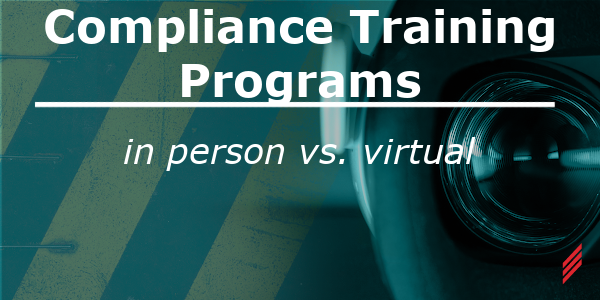Compliance Training Programs: In Person Vs. Virtual
by Ralph Parrett on Sep 11, 2023 4:44:44 PM

Workplaces of today have taken on quite a different form compared to their predecessors; and with that, this new form brings on new challenges to stay up to date with training techniques that engage and develop their employees knowledge and skills through training opportunities. This is the first blog in a three part series that will take a look at options that are available with compliance training programs such as electrical safety training, and the benefits and challenges you should take into consideration.
Compliance Training Programs : In Person Vs. Virtual
Compliance Training Programs: Digital Training
Compliance Training Programs: What is a Learning Management System (LMS)
As a professional instructor for 16 years and having attended, developed, and delivered each of the following training methods; I’d like to discuss benefits and challenges associated with them that organizations should consider before moving forward in the current training market.
Instructor-led training (ILT)
Instructor-led training (ILT) has always been a staple for training and in my opinion will and should remain a means for personnel to develop. Realizing the familiarity with this delivery method, lets review the pros and cons.
Pros
Pros of ILT are as follows and go without explanation: personal interactions with another that should have ample knowledge and experience within the subject being taught, attendees are able to ask questions as they arise and receive immediate feedback, ILT also allows “on-the-fly” adjustments by the instructor to accommodate the knowledge, experience, and weaknesses of the audience.
Cons
Cons of ILT are as follows: inconsistent topic material covered during the training sessions, coordinating the personnel that need the training along with day-to-day job duties and responsibilities; additionally, personnel have individual lives as well that personal emergencies can arise that prevent them from attending the necessary training, natural attrition and company growth needs lead to new personnel that were not presently available to attend the training, both of the previous cons lead to the need to reschedule the training which increases the strain on logistics and financial investment.
Lastly, while ILT provides the most intimate learning experience, retention of what was learned by those in attendance drastically decreases over time unless the knowledge and skills are immediately and regularly used by the attendees. The ultimate downside of ILT is depending on a constant cycle of retraining and can become burdensome over time.
Virtual Instructor-led training (VILT)
Virtual Instructor-led training (VILT) has been an option for just over 30 years, but its benefits were not appreciated until just a few years ago. VILT seemingly grew popularity and dependency over night.
Pros
The pros of VILT: it provides the learner to have as close to the same experience as they would in a physical classroom; the majority, if not all, of the information is delivered live by an instructor and not a prerecorded session. Attendants can ask questions to obtain a greater understanding of the topic or to clarify an area they may not feel they had fully grasped. Most importantly, attendants can discuss past experiences and share those with their fellow students which is vital for supporting community in the learning environment. How can this be done? Virtual training platforms offer chat windows and the ability to turn on microphones and webcams that can be used for the attendant to interact with the instructor and other attendants.
Cons
Cons of VILT are as follows: even younger generations are used to face-to-face interaction that we have all grown accustomed to inside of a classroom; while attending a virtual online class, it is common that the learner is alone and that can dampen the learning experience. The instructor is place with even greater weight on having a collaborative learning environment compared to in person. All too often the instructor just “powers through” the content and never encourages participation; however, it is not uncommon that attendees are reluctant to participate.
Lastly, VILT does not fix all of the cons of ILT; personnel being in attendance and retention issues are still relevant for this method of training.
In the next blog, we will be taking a look at digital delivery methods such as online learning and Virtual Reality.
About the Author
Ralph is a United States Navy veteran with 15 years of professional experience relating to safety and maintenance of engineering systems. He has always been driven to make a positive impact for others increase awareness, skills, and knowledge. Ralph has extensive knowledge of maintenance, repair, and troubleshooting of control and instrumentation, relay logic systems, power system equipment testing and maintenance, and other various types of equipment. He has developed and taught theory, operation, maintenance, and safety of various engineering systems.
Read My Hallam Story
About Hallam-ICS
Hallam-ICS is an engineering and automation company that designs MEP systems for facilities and plants, engineers control and automation solutions, and ensures safety and regulatory compliance through arc flash studies, commissioning, and validation. Our offices are located in Massachusetts, Connecticut, New York, Vermont, North Carolina , Texas and Florida and our projects take us world-wide.
You May Also Like
These Related Stories

The First 2 Steps to Complete your TGMS Safety Requirement Specification

5 Overlooked Components of a Great Pre-Job Briefing




Comments (1)